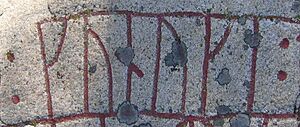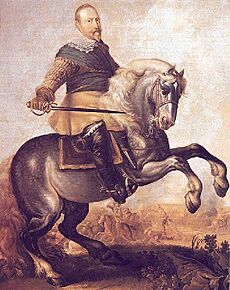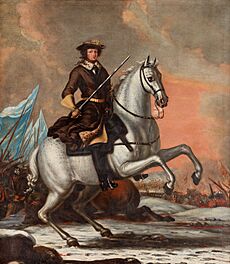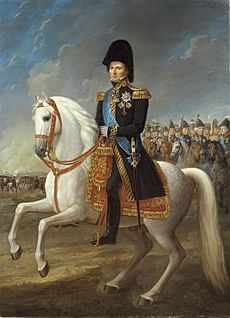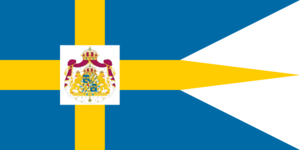Monarchy of Sweden facts for kids
Quick facts for kids His Majesty the King of Sweden |
|
|---|---|
| Sveriges Konung | |
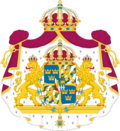
Greater coat of arms of Sweden
|
|
| Incumbent | |
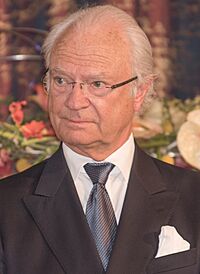 |
|
| Carl XVI Gustaf since 15 September 1973 |
|
| Details | |
| Style | His Majesty |
| Heir apparent | Crown Princess Victoria |
| First monarch | Eric the Victorious |
| Formation | 970 |
| Residences | See list |
The monarchy of Sweden is a system where a king or queen is the head of state of Sweden. It's a constitutional monarchy, meaning the monarch's power is limited by laws, and a hereditary monarchy, meaning the title is passed down through family. Sweden also has a parliamentary system, where the government is chosen by the people's representatives.
Kings have ruled in what is now Sweden for over a thousand years. It started as a system where kings were chosen, but in the 1500s, during the time of Gustav Vasa, it became hereditary. Even before that, most rulers came from a small number of powerful families.
The official count of Swedish kings usually begins with those who ruled both Svealand and Götaland as one kingdom. Sweden's monarchy is one of the oldest in the world, with a list of rulers going back to the tenth century, starting with Eric the Victorious. Over the past thousand years, the Swedish monarchy has changed, becoming the modern constitutional monarchy we see today.
The Swedish monarchy has played a big part in developing Swedish culture. For centuries, kings and queens supported arts and sciences. Many important Swedish academies and cultural places are under royal protection. This long history, even though Sweden is a very modern and liberal country, has made the monarchy quite popular.
Today, Sweden is a representative democracy with a parliamentary system. This means the people choose their leaders, and the government is based on what the people want. This is written in the Instrument of Government, which is part of Sweden's constitution. The king and the royal family have many official and unofficial duties both in Sweden and abroad. The current king is Carl XVI Gustaf, and his heir is Crown Princess Victoria.
The Swedish monarch has several homes. Some are owned by the state, and some are private. Their main official home and workplace is Stockholm Palace. Drottningholm Palace is where the royal family lives privately. Other important homes include Gripsholm Castle and Ulriksdal Palace. Many large palaces and a big part of Stockholm have been available for the monarch's use since 1809.
Contents
A Look Back: History of the Monarchy
Early Kings of Sweden
People in Scandinavia have had kings since ancient times. Even in the 1st century CE, a writer named Tacitus mentioned that the Suiones (an old Swedish tribe) had a king. However, we mostly know about Swedish kings before Eric the Victorious (who died in 995) from old Norse stories, which are not always historically accurate.
Originally, a Swedish king was like a war leader, a judge, and a priest. There are many runestones (stones with ancient writings) that remember ordinary people, but not many old writings about Swedish kings before the 1300s. Some runestones do mention kings, like Gs 11 (King Emund the Old), U 11 (King Håkan the Red), and U 861 (King Blot-Sweyn).
Around 1000 A.D., Olof Skötkonung was the first king known to rule both Svealand and Götaland. But the history for the next two centuries is unclear, with many kings whose time and power are not well known. However, the Royal Court of Sweden considers Olof's father, Eric the Victorious, to be Sweden's first king.
The king's power grew a lot when Christianity came to Sweden in the 11th century. In the centuries that followed, more and more power was gathered into the king's hands. Swedes traditionally chose a king from a special family at the Stones of Mora. The people had the right to choose the king and even remove him. These ceremonial stones were destroyed around 1515.
In the 1100s, Sweden was still dealing with power struggles between the Erik and Sverker families. This ended when a third family married into the Erik family, and the House of Bjälbo took the throne. This family helped make Sweden a strong state before the Kalmar Union. King Magnus Eriksson (who ruled from 1319–1364) even ruled Norway and Scania. After the Black Death (a terrible plague), the union became weaker, and Denmark took Scania.
In 1397, after the Black Death and internal power struggles, Queen Margaret I of Denmark brought Sweden (which included Finland then), Denmark, and Norway (which included Iceland) together in the Kalmar Union. The Swedish nobles agreed to this. But there was always tension within each country and the union, which led to fighting between Swedes and Danes in the 1400s. The union finally broke apart in the early 1500s, leading to long-lasting competition between Denmark-Norway and Sweden (with Finland) for centuries.
The 1500s and 1600s: Big Changes
| House of Vasa | |||||||||||||||||||||||||||||||||||||||||||||||||||||||||||||||||||||||||||||||||||||||||||||||||||||||||||||||||||||||||||||||||||||||||||||||||||||||||||||||||||||||||||||||||||||||||||||||||||||||||||||||||||||||||||||||||||||||||||||||||||||||||||||||||||||||||||||||||||||||||||||||||||||||||||||||||||||||||||||||||||||||||||||||||||||||||||||||||||||||||||||||||||||||||||||||||||||||||||||||||||||||||||||||||||||||||||||||||||||||||||||||||||||||||||||||||||||||||||||||||||||||||||||||||||||||||||||||||||||||||||||||||||||||||||||||||||||||||||||||||||||||||||||||||||||||||||||||||||||||||||||||||||||||||||||||||||||||||||||||||||||||||||||||||||||||||||||||||||||||||||||||||||||||||||||||||||||||||||||||||||||||||||||||||||||||||||||||||||||||||||||||||||||||||||||||||||||||||||||||||||||||||||||||||||||||||||||||||||||||||||||||||||||||||||||||||||||||||||||||||||||||||||||||||||||||||||||||||||||||||||||||||||||||||||||
|---|---|---|---|---|---|---|---|---|---|---|---|---|---|---|---|---|---|---|---|---|---|---|---|---|---|---|---|---|---|---|---|---|---|---|---|---|---|---|---|---|---|---|---|---|---|---|---|---|---|---|---|---|---|---|---|---|---|---|---|---|---|---|---|---|---|---|---|---|---|---|---|---|---|---|---|---|---|---|---|---|---|---|---|---|---|---|---|---|---|---|---|---|---|---|---|---|---|---|---|---|---|---|---|---|---|---|---|---|---|---|---|---|---|---|---|---|---|---|---|---|---|---|---|---|---|---|---|---|---|---|---|---|---|---|---|---|---|---|---|---|---|---|---|---|---|---|---|---|---|---|---|---|---|---|---|---|---|---|---|---|---|---|---|---|---|---|---|---|---|---|---|---|---|---|---|---|---|---|---|---|---|---|---|---|---|---|---|---|---|---|---|---|---|---|---|---|---|---|---|---|---|---|---|---|---|---|---|---|---|---|---|---|---|---|---|---|---|---|---|---|---|---|---|---|---|---|---|---|---|---|---|---|---|---|---|---|---|---|---|---|---|---|---|---|---|---|---|---|---|---|---|---|---|---|---|---|---|---|---|---|---|---|---|---|---|---|---|---|---|---|---|---|---|---|---|---|---|---|---|---|---|---|---|---|---|---|---|---|---|---|---|---|---|---|---|---|---|---|---|---|---|---|---|---|---|---|---|---|---|---|---|---|---|---|---|---|---|---|---|---|---|---|---|---|---|---|---|---|---|---|---|---|---|---|---|---|---|---|---|---|---|---|---|---|---|---|---|---|---|---|---|---|---|---|---|---|---|---|---|---|---|---|---|---|---|---|---|---|---|---|---|---|---|---|---|---|---|---|---|---|---|---|---|---|---|---|---|---|---|---|---|---|---|---|---|---|---|---|---|---|---|---|---|---|---|---|---|---|---|---|---|---|---|---|---|---|---|---|---|---|---|---|---|---|---|---|---|---|---|---|---|---|---|---|---|---|---|---|---|---|---|---|---|---|---|---|---|---|---|---|---|---|---|---|---|---|---|---|---|---|---|---|---|---|---|---|---|---|---|---|---|---|---|---|---|---|---|---|---|---|---|---|---|---|---|---|---|---|---|---|---|---|---|---|---|---|---|---|---|---|---|---|---|---|---|---|---|---|---|---|---|---|---|---|---|---|---|---|---|---|---|---|---|---|---|---|---|---|---|---|---|---|---|---|---|---|---|---|---|---|---|---|---|---|---|---|---|---|---|---|---|---|---|---|---|---|---|---|---|---|---|---|---|---|---|---|---|---|---|---|---|---|---|---|---|---|---|---|---|---|---|---|---|---|---|---|---|---|---|---|---|---|---|---|---|---|---|---|---|---|---|---|---|---|---|---|---|---|---|---|---|---|---|---|---|---|---|---|---|---|---|---|---|---|---|---|---|---|---|---|---|---|---|---|---|---|---|---|---|---|---|---|---|---|---|---|---|---|---|---|---|---|---|---|---|---|---|---|---|---|---|---|---|---|---|---|---|---|---|---|---|---|---|---|---|---|---|---|---|---|---|---|---|---|---|---|---|---|---|---|---|---|---|---|---|---|---|---|---|---|---|---|---|---|---|---|---|---|---|---|---|---|---|---|---|---|---|---|---|---|---|---|---|---|---|---|---|---|---|---|---|---|---|---|---|---|---|---|---|---|---|---|---|---|---|---|---|---|---|---|---|---|---|---|---|---|---|---|---|---|---|---|---|---|---|---|---|---|---|---|---|---|---|---|---|---|---|---|---|---|---|---|---|---|---|---|---|---|---|---|---|---|---|---|---|---|---|---|---|---|---|---|---|---|---|---|---|---|---|---|---|---|---|---|---|---|---|---|---|---|---|---|---|---|---|---|---|---|---|---|---|---|---|---|---|---|---|---|---|---|---|---|---|---|---|---|---|---|---|---|---|---|---|---|---|---|---|---|---|---|---|---|---|---|---|---|---|---|---|---|---|---|---|---|---|---|---|---|---|---|---|---|---|---|---|---|---|---|---|---|---|---|---|---|---|---|---|---|---|---|---|---|---|---|---|---|---|---|---|---|---|---|---|---|---|---|---|---|---|---|---|---|---|---|---|---|---|---|---|---|---|---|---|---|---|---|---|---|---|---|---|
|
|||||||||||||||||||||||||||||||||||||||||||||||||||||||||||||||||||||||||||||||||||||||||||||||||||||||||||||||||||||||||||||||||||||||||||||||||||||||||||||||||||||||||||||||||||||||||||||||||||||||||||||||||||||||||||||||||||||||||||||||||||||||||||||||||||||||||||||||||||||||||||||||||||||||||||||||||||||||||||||||||||||||||||||||||||||||||||||||||||||||||||||||||||||||||||||||||||||||||||||||||||||||||||||||||||||||||||||||||||||||||||||||||||||||||||||||||||||||||||||||||||||||||||||||||||||||||||||||||||||||||||||||||||||||||||||||||||||||||||||||||||||||||||||||||||||||||||||||||||||||||||||||||||||||||||||||||||||||||||||||||||||||||||||||||||||||||||||||||||||||||||||||||||||||||||||||||||||||||||||||||||||||||||||||||||||||||||||||||||||||||||||||||||||||||||||||||||||||||||||||||||||||||||||||||||||||||||||||||||||||||||||||||||||||||||||||||||||||||||||||||||||||||||||||||||||||||||||||||||||||||||||||||||||||||||||

Catholic bishops had supported the King of Denmark, Christian II. But he was overthrown in a rebellion led by a nobleman named Gustav Vasa. Gustav Vasa (also called Gustav I) was chosen as King of Sweden by the country's leaders on June 6, 1523.
Gustav I was inspired by the ideas of Martin Luther and used the Protestant Reformation to reduce the power of the Roman Catholic Church. In 1527, he convinced the leaders to take over church lands, which made up 21% of the country's farmland. At the same time, he broke away from the Pope and created a new state church: the Church of Sweden. During his rule, Gustav I stopped opposition from nobles and farmers who disagreed with his church policies and his efforts to centralize power. This helped create the modern Swedish state. Sweden officially became a hereditary monarchy in 1544. This meant that Gustav I's sons would inherit the throne.
Tax changes happened in 1538 and 1558. Many complicated taxes on farmers were made simpler and fairer. The king's tax money increased, and people felt the new system was more just. A war with Lübeck in 1535 led to the removal of the Hanseatic traders, who used to control foreign trade. With Swedish citizens in charge, Sweden's economy grew quickly. By 1544, Gustav controlled 60% of all farmland in Sweden. Sweden then built the first modern army in Europe, supported by a good tax system and efficient government workers.
When King Gustav I died in 1560, his oldest son Eric XIV became king. His rule was marked by Sweden joining the Livonian War and the Northern Seven Years' War. Eric's mental health problems and his disagreements with the nobles led to the Sture Murders in 1567. His brother John (III) was imprisoned. In 1568, Eric was removed from the throne, and John III became king. John III showed some support for the Catholic Church, which caused problems with the Swedish clergy and nobles. He brought back some Catholic traditions that had been removed. His foreign policy was influenced by his family ties to Poland, where his oldest son had become King Sigismund III Vasa in 1587. After his father's death, Sigismund tried to rule Sweden from Poland. He left Sweden under the control of his uncle, Charles (IX). But Sigismund could not defend his Swedish throne against his uncle's ambitions. In 1598, Charles's forces defeated Sigismund's army at the Battle of Stångebro. Sigismund was declared removed from the throne in 1599.
In 1604, the country's leaders finally recognized Charles IX as king. His short rule was filled with wars. He fought with Poland and Russia over land. He also started a war with Denmark in his last year.
Gustavus Adolphus inherited three wars from his father when he became king. From 1612, when Axel Oxenstierna became the top government official, the two men worked together very well. Oxenstierna's calm nature balanced the King's passion. The war against Russia ended in 1617, which blocked Russia from the Baltic Sea. The war against Poland ended in 1629, giving Sweden a large area called Livonia. This freed up Swedish forces to join the Thirty Years' War in Germany. Gustavus Adolphus was killed in the Battle of Lützen in 1632. His young daughter Christina became queen, and her mother and the king's ministers governed until Christina was old enough. Gustavus Adolphus is often seen as one of the greatest military leaders ever.
Christina became queen at age six. A group of regents (people who rule for a young monarch) governed for her until she turned 18. During this time, Chancellor Axel Oxenstierna wrote the 1634 Instrument of Government, which helped guide the government. Christina was very interested in books and science. She famously invited René Descartes, a famous philosopher, to Sweden. Sweden continued to be involved in the Thirty Years' War during Christina's reign. This conflict ended with the Peace of Westphalia in 1648. Sweden gained land in Germany. Christina decided not to marry and gave up her throne on June 5, 1654, to her cousin Charles X Gustav. She then left Sweden and became a Catholic.
| House of Wittelsbach (Palatine-Zweibrucken branch) on the Swedish Throne | |||||||||||||||||||||||||||||||||||||||||||||||||||||||||||||||||||||||||||||||||||||||||||||||||||||||||||||||||||||||||||||||||||||||||||||||||||||||||||||||||||||||||||||||||||||||||||||||||||||||||||||||||||||||||||||||||||||||||||||||||||||||||||||||||||||||||||||||||||||||||||||||||||||||||||||||||||||||||||||||||||||||||||||||||||||||||||||||||||||||||||||||||||||||||||||||||||||||||||||||||||||||||||||||||||||||||||||||||||||||||||||||||||||||||||||||||||||||||||||||||||||||||||||||||||||||||||||||||||||||||||||||||||||||||||||||||||||||||||||||||||||||||||||||||||||||||||||||||||||||||||||||||||||||||||||||||||||||||||||||||||||||||||||||||||||||||||||||||||||||||||||||||||||||||||||||||||||||||||||||||||||||||||||||||||||||||||||||||||||||||||||||||||||||||||||||||||||||||||||||||||||||||||||||||||||||||||||||||||||||||||||||||||||||||||||||||
|---|---|---|---|---|---|---|---|---|---|---|---|---|---|---|---|---|---|---|---|---|---|---|---|---|---|---|---|---|---|---|---|---|---|---|---|---|---|---|---|---|---|---|---|---|---|---|---|---|---|---|---|---|---|---|---|---|---|---|---|---|---|---|---|---|---|---|---|---|---|---|---|---|---|---|---|---|---|---|---|---|---|---|---|---|---|---|---|---|---|---|---|---|---|---|---|---|---|---|---|---|---|---|---|---|---|---|---|---|---|---|---|---|---|---|---|---|---|---|---|---|---|---|---|---|---|---|---|---|---|---|---|---|---|---|---|---|---|---|---|---|---|---|---|---|---|---|---|---|---|---|---|---|---|---|---|---|---|---|---|---|---|---|---|---|---|---|---|---|---|---|---|---|---|---|---|---|---|---|---|---|---|---|---|---|---|---|---|---|---|---|---|---|---|---|---|---|---|---|---|---|---|---|---|---|---|---|---|---|---|---|---|---|---|---|---|---|---|---|---|---|---|---|---|---|---|---|---|---|---|---|---|---|---|---|---|---|---|---|---|---|---|---|---|---|---|---|---|---|---|---|---|---|---|---|---|---|---|---|---|---|---|---|---|---|---|---|---|---|---|---|---|---|---|---|---|---|---|---|---|---|---|---|---|---|---|---|---|---|---|---|---|---|---|---|---|---|---|---|---|---|---|---|---|---|---|---|---|---|---|---|---|---|---|---|---|---|---|---|---|---|---|---|---|---|---|---|---|---|---|---|---|---|---|---|---|---|---|---|---|---|---|---|---|---|---|---|---|---|---|---|---|---|---|---|---|---|---|---|---|---|---|---|---|---|---|---|---|---|---|---|---|---|---|---|---|---|---|---|---|---|---|---|---|---|---|---|---|---|---|---|---|---|---|---|---|---|---|---|---|---|---|---|---|---|---|---|---|---|---|---|---|---|---|---|---|---|---|---|---|---|---|---|---|---|---|---|---|---|---|---|---|---|---|---|---|---|---|---|---|---|---|---|---|---|---|---|---|---|---|---|---|---|---|---|---|---|---|---|---|---|---|---|---|---|---|---|---|---|---|---|---|---|---|---|---|---|---|---|---|---|---|---|---|---|---|---|---|---|---|---|---|---|---|---|---|---|---|---|---|---|---|---|---|---|---|---|---|---|---|---|---|---|---|---|---|---|---|---|---|---|---|---|---|---|---|---|---|---|---|---|---|---|---|---|---|---|---|---|---|---|---|---|---|---|---|---|---|---|---|---|---|---|---|---|---|---|---|---|---|---|---|---|---|---|---|---|---|---|---|---|---|---|---|---|---|---|---|---|---|---|---|---|---|---|---|---|---|---|---|---|---|---|---|---|---|---|---|---|---|---|---|---|---|---|---|---|---|---|---|---|---|---|---|---|---|---|---|---|---|---|---|---|---|---|---|---|---|---|---|---|---|---|---|---|---|---|---|---|---|---|---|---|---|---|---|---|---|---|---|---|---|---|---|---|---|---|---|---|---|---|---|---|---|---|---|---|---|---|---|---|---|---|---|---|---|---|---|---|---|---|---|---|---|---|---|---|---|---|---|---|---|---|---|---|---|---|---|---|---|---|---|---|---|---|---|---|---|---|---|---|---|---|---|---|---|---|---|---|---|---|---|---|---|---|---|---|---|---|---|---|---|---|---|---|---|---|---|---|---|---|---|---|---|---|---|---|---|---|---|---|---|---|---|---|---|---|---|---|---|---|---|---|---|---|---|---|---|---|---|---|---|---|---|---|---|---|---|---|---|---|---|---|---|---|---|---|---|---|---|---|---|---|---|---|---|---|---|---|---|---|---|---|---|---|---|---|---|---|---|---|---|---|---|---|---|---|---|---|---|---|---|---|---|---|---|---|---|---|---|---|---|---|---|---|---|---|---|---|---|---|---|---|---|---|---|---|---|---|---|---|---|---|---|---|---|---|---|---|---|---|---|---|---|---|---|
|
|||||||||||||||||||||||||||||||||||||||||||||||||||||||||||||||||||||||||||||||||||||||||||||||||||||||||||||||||||||||||||||||||||||||||||||||||||||||||||||||||||||||||||||||||||||||||||||||||||||||||||||||||||||||||||||||||||||||||||||||||||||||||||||||||||||||||||||||||||||||||||||||||||||||||||||||||||||||||||||||||||||||||||||||||||||||||||||||||||||||||||||||||||||||||||||||||||||||||||||||||||||||||||||||||||||||||||||||||||||||||||||||||||||||||||||||||||||||||||||||||||||||||||||||||||||||||||||||||||||||||||||||||||||||||||||||||||||||||||||||||||||||||||||||||||||||||||||||||||||||||||||||||||||||||||||||||||||||||||||||||||||||||||||||||||||||||||||||||||||||||||||||||||||||||||||||||||||||||||||||||||||||||||||||||||||||||||||||||||||||||||||||||||||||||||||||||||||||||||||||||||||||||||||||||||||||||||||||||||||||||||||||||||||||||||||||||
The country's leaders chose Charles X Gustav as their new King. His short rule was mostly about wars. First, he led a long campaign in Poland, then fought with Denmark. In the war with Denmark, his risky 1658 March across the Belts led to Sweden gaining a lot of land permanently: Skåne, Blekinge, and Bohuslän became Swedish provinces. Charles X Gustav wanted to completely defeat Denmark, but his attack on Copenhagen in 1659 failed, mainly because the Dutch navy helped the Danes.
Charles X Gustav died in Gothenburg in 1660. His five-year-old son Charles XI became king, and a new group of regents took over. This group of nobles was more interested in their own wealth than the country's good. When Charles XI became an adult in 1672, the army was weak, and Sweden was not ready when the King of Denmark, Christian V, invaded to get revenge. The Danes did not succeed. Charles XI then took steps to prevent this from happening again. He reduced the power of the nobles by taking back lands and properties his predecessors had given them. He also introduced the Allotment system (Swedish: indelningsverket), which was the basis of the armed forces until the 1900s. With the support of the country's leaders, he was declared an absolute monarch in 1680.
Charles XI was followed by his son, Charles XII. He was a very skilled military leader, defeating much larger enemies with his small but professional Swedish army. His victory over the Russians at Narva when he was just 18 was his greatest success. However, his long campaigns during the Great Northern War eventually led to a terrible defeat at the Battle of Poltava. After that, he spent several years in what is now Moldova. Some years later, he was killed during an attempt to invade Norway. This marked the end of Sweden's "Age of Greatness."
From the 1700s to Today
| House of Oldenburg (Schleswig-Holstein-Gottorp branch) & Succession to the Swedish Throne | |||||||||||||||||||||||||||||||||||||||||||||||||||||||||||||||||||||||||||||||||||||||||||||||||||||||||||||||||||||||||||||||||||||||||||||||||||||||||||||||||||||||||||||||||||||||||||||||||||||||||||||||||||||||||||||||||||||||||||||||||||||||||||||||||||||||||||||||||||||||||||||||||||||||||||||||||||||||||||||||||||||||||||||||||||||||||||||||||||||||||||||||||||||||||||||||||||||||||||||||||||||||||||||||||||||||||||||||||||||||||||||||||||||||||||||||||||||||||||||||||||||||||||||||||||||||||||||||||||||||||||||||||||||||||||||||||||||||||||||||||||||||||||||||||||||||||||||||||||||||||||||||||||||||||||||||||||||||||||||
|---|---|---|---|---|---|---|---|---|---|---|---|---|---|---|---|---|---|---|---|---|---|---|---|---|---|---|---|---|---|---|---|---|---|---|---|---|---|---|---|---|---|---|---|---|---|---|---|---|---|---|---|---|---|---|---|---|---|---|---|---|---|---|---|---|---|---|---|---|---|---|---|---|---|---|---|---|---|---|---|---|---|---|---|---|---|---|---|---|---|---|---|---|---|---|---|---|---|---|---|---|---|---|---|---|---|---|---|---|---|---|---|---|---|---|---|---|---|---|---|---|---|---|---|---|---|---|---|---|---|---|---|---|---|---|---|---|---|---|---|---|---|---|---|---|---|---|---|---|---|---|---|---|---|---|---|---|---|---|---|---|---|---|---|---|---|---|---|---|---|---|---|---|---|---|---|---|---|---|---|---|---|---|---|---|---|---|---|---|---|---|---|---|---|---|---|---|---|---|---|---|---|---|---|---|---|---|---|---|---|---|---|---|---|---|---|---|---|---|---|---|---|---|---|---|---|---|---|---|---|---|---|---|---|---|---|---|---|---|---|---|---|---|---|---|---|---|---|---|---|---|---|---|---|---|---|---|---|---|---|---|---|---|---|---|---|---|---|---|---|---|---|---|---|---|---|---|---|---|---|---|---|---|---|---|---|---|---|---|---|---|---|---|---|---|---|---|---|---|---|---|---|---|---|---|---|---|---|---|---|---|---|---|---|---|---|---|---|---|---|---|---|---|---|---|---|---|---|---|---|---|---|---|---|---|---|---|---|---|---|---|---|---|---|---|---|---|---|---|---|---|---|---|---|---|---|---|---|---|---|---|---|---|---|---|---|---|---|---|---|---|---|---|---|---|---|---|---|---|---|---|---|---|---|---|---|---|---|---|---|---|---|---|---|---|---|---|---|---|---|---|---|---|---|---|---|---|---|---|---|---|---|---|---|---|---|---|---|---|---|---|---|---|---|---|---|---|---|---|---|---|---|---|---|---|---|---|---|---|---|---|---|---|---|---|---|---|---|---|---|---|---|---|---|---|---|---|---|---|---|---|---|---|---|---|---|---|---|---|---|---|---|---|---|---|---|---|---|---|---|---|---|---|---|---|---|---|---|---|---|---|---|---|---|---|---|---|---|---|---|---|---|---|---|---|---|---|---|---|---|---|---|---|---|---|---|---|---|---|---|---|---|---|---|---|---|---|---|---|---|---|---|---|---|---|---|---|---|---|---|---|---|---|---|---|---|---|---|---|---|---|---|---|---|---|---|---|---|---|---|---|---|---|---|---|---|---|---|---|---|---|---|---|---|---|---|---|---|---|---|---|---|---|---|---|---|---|---|---|---|---|---|---|---|---|---|---|---|---|---|---|---|---|---|---|---|---|---|---|---|---|---|---|---|---|---|---|---|---|---|---|---|---|---|---|---|---|---|---|---|---|---|---|---|---|---|---|---|
|
|||||||||||||||||||||||||||||||||||||||||||||||||||||||||||||||||||||||||||||||||||||||||||||||||||||||||||||||||||||||||||||||||||||||||||||||||||||||||||||||||||||||||||||||||||||||||||||||||||||||||||||||||||||||||||||||||||||||||||||||||||||||||||||||||||||||||||||||||||||||||||||||||||||||||||||||||||||||||||||||||||||||||||||||||||||||||||||||||||||||||||||||||||||||||||||||||||||||||||||||||||||||||||||||||||||||||||||||||||||||||||||||||||||||||||||||||||||||||||||||||||||||||||||||||||||||||||||||||||||||||||||||||||||||||||||||||||||||||||||||||||||||||||||||||||||||||||||||||||||||||||||||||||||||||||||||||||||||||||||
Charles XII's sister, Ulrika Eleonora, became queen. She had to sign the 1719 Instrument of Government. This document ended the absolute monarchy and made the Riksdag of the Estates (the parliament) the most powerful part of the government. The monarch's role became mostly ceremonial. This period was called the "Age of Liberty." Ulrika Eleonora ruled for only a year and then gave the throne to her husband, Frederick. He was elected King Frederick I and had little interest in governing. He never had a legitimate child to inherit the throne.
Adolf Frederick became king in 1751. During his 20-year reign, he was mostly a figurehead, meaning he had little real power. The Riksdag, often divided by political parties, held the true power. Adolf Frederick tried twice to get more power back, but he was not successful.
Adolf Frederick's son, King Gustav III, was more successful in bringing back royal authority. In 1772, he changed the government system, giving the king more power.
In 1809, Sweden lost Finland to Russia after a war. King Gustav IV Adolf and his family were removed from power by unhappy army officers. The former king's uncle, who had no children, was almost immediately chosen as King Charles XIII. The Instrument of Government of 1809 ended the king's absolute power. It divided law-making power between the Riksdag (parliament) and the king. The king held executive power when working with the Council of State.
The current royal family, the Bernadotte dynasty, began in September 1810. The Riksdag chose a French Marshal named Jean-Baptiste Jules Bernadotte as crown prince. This happened because Charles XIII had no legal heir, and the previous crown prince had suddenly died.
Throughout the 1800s, the Bernadotte monarchs tried to keep their power. However, the influence of the king slowly decreased as liberal and social democratic ideas grew, and more people gained the right to vote.
Princess Sofia Wilhelmina, the daughter of Gustav IV Adolf, married Leopold of Baden. Their granddaughter Victoria of Baden married the Bernadotte king Gustaf V of Sweden. The current King Carl XVI Gustaf is therefore a descendant of Gustav IV through his grandfather, Gustaf VI Adolf.
| House of Bernadotte and Link to Earlier Swedish Dynasties | |||||||||||||||||||||||||||||||||||||||||||||||||||||||||||||||||||||||||||||||||||||||||||||||||||||||||||||||||||||||||||||||||||||||||||||||||||||||||||||||||||||||||||||||||||||||||||||||||||||||||||||||||||||||||||||||||||||||||||||||||||||||||||||||||||||||||||||||||||||||||||||||||||||||||||||||||||||||||||||||||||||||||||||||||||||||||||||||||||||||||||||||||||||||||||||||||||||||||||||||||||||||||||||||||||||||||||||||||||||||||||||||||||||||||||||||||||||||||||||||||||||||||||||||||||||||||||||||||||||||||||||||||||||||||||||||||||||||||||||||||||||||||||||||||||||||||||||||||||||||||||||||||||||||||||||||||||||||||||||||||||||||||||||||||||||||||||||||||||||||||||||||||||||||||||||||||||||||||||||||||||||||||||||||||||||||||||||||||
|---|---|---|---|---|---|---|---|---|---|---|---|---|---|---|---|---|---|---|---|---|---|---|---|---|---|---|---|---|---|---|---|---|---|---|---|---|---|---|---|---|---|---|---|---|---|---|---|---|---|---|---|---|---|---|---|---|---|---|---|---|---|---|---|---|---|---|---|---|---|---|---|---|---|---|---|---|---|---|---|---|---|---|---|---|---|---|---|---|---|---|---|---|---|---|---|---|---|---|---|---|---|---|---|---|---|---|---|---|---|---|---|---|---|---|---|---|---|---|---|---|---|---|---|---|---|---|---|---|---|---|---|---|---|---|---|---|---|---|---|---|---|---|---|---|---|---|---|---|---|---|---|---|---|---|---|---|---|---|---|---|---|---|---|---|---|---|---|---|---|---|---|---|---|---|---|---|---|---|---|---|---|---|---|---|---|---|---|---|---|---|---|---|---|---|---|---|---|---|---|---|---|---|---|---|---|---|---|---|---|---|---|---|---|---|---|---|---|---|---|---|---|---|---|---|---|---|---|---|---|---|---|---|---|---|---|---|---|---|---|---|---|---|---|---|---|---|---|---|---|---|---|---|---|---|---|---|---|---|---|---|---|---|---|---|---|---|---|---|---|---|---|---|---|---|---|---|---|---|---|---|---|---|---|---|---|---|---|---|---|---|---|---|---|---|---|---|---|---|---|---|---|---|---|---|---|---|---|---|---|---|---|---|---|---|---|---|---|---|---|---|---|---|---|---|---|---|---|---|---|---|---|---|---|---|---|---|---|---|---|---|---|---|---|---|---|---|---|---|---|---|---|---|---|---|---|---|---|---|---|---|---|---|---|---|---|---|---|---|---|---|---|---|---|---|---|---|---|---|---|---|---|---|---|---|---|---|---|---|---|---|---|---|---|---|---|---|---|---|---|---|---|---|---|---|---|---|---|---|---|---|---|---|---|---|---|---|---|---|---|---|---|---|---|---|---|---|---|---|---|---|---|---|---|---|---|---|---|---|---|---|---|---|---|---|---|---|---|---|---|---|---|---|---|---|---|---|---|---|---|---|---|---|---|---|---|---|---|---|---|---|---|---|---|---|---|---|---|---|---|---|---|---|---|---|---|---|---|---|---|---|---|---|---|---|---|---|---|---|---|---|---|---|---|---|---|---|---|---|---|---|---|---|---|---|---|---|---|---|---|---|---|---|---|---|---|---|---|---|---|---|---|---|---|---|---|---|---|---|---|---|---|---|---|---|---|---|---|---|---|---|---|---|---|---|---|---|---|---|---|---|---|---|---|---|---|---|---|---|---|---|---|---|---|---|---|---|---|---|---|---|---|---|---|---|---|---|---|---|---|---|---|---|---|---|---|---|---|---|---|---|---|---|---|---|---|---|---|---|---|---|---|---|---|---|---|---|---|---|---|---|---|---|---|---|---|---|---|---|---|---|---|---|---|---|---|---|---|---|---|---|---|---|---|---|---|---|---|---|---|---|---|---|---|---|---|---|---|---|---|---|---|---|---|---|---|---|---|---|---|---|---|---|---|---|---|---|---|---|---|---|---|---|---|---|---|---|---|---|---|---|---|---|---|---|---|---|---|---|---|---|---|---|---|---|---|---|---|---|---|---|---|---|---|---|---|---|---|---|---|---|---|---|---|---|---|---|---|---|---|---|---|---|---|---|---|---|---|---|---|---|---|---|---|---|---|---|---|---|---|---|---|---|---|
|
|||||||||||||||||||||||||||||||||||||||||||||||||||||||||||||||||||||||||||||||||||||||||||||||||||||||||||||||||||||||||||||||||||||||||||||||||||||||||||||||||||||||||||||||||||||||||||||||||||||||||||||||||||||||||||||||||||||||||||||||||||||||||||||||||||||||||||||||||||||||||||||||||||||||||||||||||||||||||||||||||||||||||||||||||||||||||||||||||||||||||||||||||||||||||||||||||||||||||||||||||||||||||||||||||||||||||||||||||||||||||||||||||||||||||||||||||||||||||||||||||||||||||||||||||||||||||||||||||||||||||||||||||||||||||||||||||||||||||||||||||||||||||||||||||||||||||||||||||||||||||||||||||||||||||||||||||||||||||||||||||||||||||||||||||||||||||||||||||||||||||||||||||||||||||||||||||||||||||||||||||||||||||||||||||||||||||||||||||
Before World War I, King Gustaf V publicly disagreed with the government's plans to cut the defense budget. This event, known as the Courtyard Crisis, was seen as a challenge to the idea of a parliamentary system. It led to the Prime Minister, Karl Staaff, resigning. Gustaf V then appointed a temporary government. This government stayed in power longer than expected because World War I started (Sweden remained neutral). By then, increasing defense spending was no longer a problem.
However, social tensions continued to rise, especially around the time of the Russian Revolution in 1917. The election in 1917 gave liberals and social democrats much more power in parliament. A conservative government was no longer possible. After 1917, the king's political influence was greatly reduced. This set an unwritten rule that lasted until 1975.
During World War II, in what was called the Midsummer crisis, Gustaf V reportedly tried to get involved in politics. He threatened to give up his throne if Sweden did not allow German troops to travel through the country by train from Norway to Finland.
King Gustaf VI Adolf became king in 1950 after his father died. He was generally seen as a constitutional monarch who stayed out of politics. In 1954, a group began to study whether Sweden should change its constitution. They decided to write a new one. The future role of the monarchy was decided in 1971 at a meeting called the Torekov compromise. Representatives from four political parties agreed that the monarchy would remain, but it would become entirely ceremonial, with no political power left.
After two votes in the Riksdag in 1973 and 1974, a new Instrument of Government came into effect. The monarch's duties, as described in the 1974 Constitution Act, include leading a special government meeting when there's a change in government. But the monarch has no executive power in running the country.
Carl XVI Gustaf became king on September 15, 1973, after his grandfather Gustaf VI Adolf passed away. Because his father died young, Carl XVI Gustaf has become the longest-reigning monarch in Swedish history. His King's Golden Jubilee was celebrated in 2023, marking 50 years on the throne.
The Monarch's Role Today
On January 1, 1975, the Instrument of Government of 1974 replaced the older 1809 version. This new law changed the Council of State into the Government. All executive power was given to the Government. The power to choose and remove the prime minister (who is now elected by the Riksdag) was given to the Speaker of the Riksdag. The prime minister then chooses and removes other ministers. Also, laws passed by the Riksdag become law without the king's approval. The prime minister or another minister simply signs them "On Behalf of the Government."
Even though the king's political power was reduced in 1917, the 1971 Torekov compromise confirmed that the monarchy would be mostly ceremonial. The main reason for these changes in 1975 was to clearly describe how the government works and how decisions are made. The Minister of Justice, Lennart Geijer, said that any idea of the king being involved in government decisions would be "fictitious" and "unsatisfactory."
So, the monarch lost all formal executive powers. The king became a ceremonial figurehead who represents the country. The monarch is called the "Head of State" in the 1974 Instrument of Government. The king or queen cannot be charged with crimes while in office. However, other members of the royal family or staff at the Royal Court do not have this protection.
At the request of the Speaker of the Riksdag, the monarch officially opens the annual session of the Riksdag. The king or queen also receives official documents from foreign ambassadors and signs those for Swedish ambassadors going abroad. The monarch also leads the Cabinet Council when a new government is formed. They also lead information councils about four times a year to get updates from the Government. It is the prime minister's job to keep the monarch informed about the country's affairs. The monarch also leads the Advisory Council on Foreign Affairs. This group allows the government to share secret information about foreign issues with the head of state and opposition parties.
The monarch is no longer the commander-in-chief of the Swedish Armed Forces. However, the monarch is the main representative of Sweden's defense and holds the highest rank in each military branch. The king is a four-star admiral in the Swedish Navy and a general in the Swedish Army and Air Force. The monarch has a military staff that includes active military officers who serve as aides-de-camp to the royal family.
The Monarchy's Cultural Role
The monarch and members of the Royal Family have many official and unofficial duties both in Sweden and abroad. The royal family plays a key role in state visits to Sweden and makes state visits to other countries on behalf of Sweden. Other royal family members may also represent the country at smaller events abroad.
Many of Sweden's official flag days are connected to the royal family. These include the name days of the King, Queen, and Crown Princess. They also include the birthdays of the King, Queen, and Crown Princess. Gustavus Adolphus Day on November 6 remembers King Gustavus Adolphus, who died on that date in 1632. None of these flag days are public holidays.
Perhaps the most famous event where the Royal Family participates each year is the Nobel Prize award ceremony. This is held at the Stockholm Concert Hall. The monarch hands out the Nobel Prizes for amazing contributions to humanity in physics, chemistry, literature, medicine, and economic sciences.
Eriksgata was the name of a traditional journey that newly chosen medieval Swedish kings took through important provinces. This was to have their election confirmed by local assemblies. The actual election happened at the Stone of Mora. Since 1544, when the monarchy became hereditary, the Eriksgata had less practical importance. The last king to travel the Eriksgata in the old way was Charles IX, whose rule began in 1604. Later kings, even today, have visited all Swedish provinces and called these visits an Eriksgata, but they are very different from the old tradition.
Royal Titles
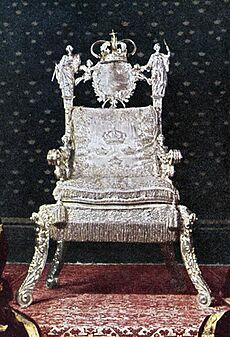
The Monarch's Title
From 1523 to 1973, the full title of the Swedish monarch was:
During the rule of the House of Holstein-Gottorp from 1751 to 1818, the title Heir to Norway was also used. When Norway was united with Sweden after the Napoleonic Wars, the title included King of Norway.
When he became king, Carl XVI Gustaf chose a simpler title: Sveriges Konung (King of Sweden).
Titles for Royal Family Members
The usual title for the heir apparent (the person next in line to the throne) is crown prince (kronprins) or crown princess (kronprinsessa). The wife of a crown prince also gets a similar title. However, the husband of a crown princess does not. Until 1980, other male heirs were called hereditary prince (arvfurste), though "prince" was also used. Female heirs are called princess (prinsessa).
The Swedish Succession Act was changed in 1980 to allow women to inherit the throne. This meant that Princess Victoria became crown princess, even though her younger brother, Prince Carl Philip, was born as crown prince a few months before.
Today, Article 1 of the Act of Succession limits who can inherit the throne to only the descendants of Carl XVI Gustaf. If the royal family were to end, the Riksdag is not required to choose a new royal family.
Ducal Titles
King Gustav III brought back an old tradition of giving male heirs to the throne ducal titles of Swedish provinces. Unlike in the past, these titles are now honorary and are given at birth. Since 1980, they have been given to all royal heirs, both male and female. The wives of royal dukes have always shared their husbands' titles. Since 2010, the husbands of royal duchesses also share their wives' titles.
Symbols of the Monarchy
Royal Jewels and Objects
The regalia of Sweden (royal jewels and symbols of power) are kept deep in the vaults of the Treasury chamber (Swedish: Skattkammaren). This is a museum located under the Royal Palace in Stockholm and has been open to the public since 1970. Some of the oldest items include the sword of Gustav Vasa and the crown, orb, scepter, and key of King Erik XIV. The Regalia belongs to the state, and the Legal, Financial and Administrative Services Agency is responsible for it.
The last king to have a coronation (a ceremony where the crown is placed on the monarch's head) was Oscar II. His son, Gustaf V, chose not to have one. While crowns and other royal headwear have not been worn by Swedish royalty since 1907, they are still displayed at royal events like weddings, christenings, and funerals. Until 1974, the crown and scepter were also displayed next to the Silver Throne at the annual opening of the Riksdag.
Royal Orders of Chivalry
Royal orders have a long history, going back to 1606. The Royal Orders of Knights of Sweden were officially established in 1748 by King Frederick I. In 1974, the Riksdag changed the rules for giving out these honors. No Swedish citizen outside the Royal Family could receive them. The Order of the Seraphim (Swedish: Serafimerorden) is only given to foreign heads of state and members of royal families. The Order of the Polar Star (Swedish: Nordstjärneorden) was only given to non-Swedish citizens. After these changes, the Order of the Sword and the Order of Vasa were no longer given out. In 2022, the government suggested a new change that took effect in 2023. This change allows Swedish citizens to receive Royal Orders again. However, the Order of the Seraphim was not affected by these changes.
Between 1975 and 2023, H. M. The King's Medal (Swedish: H.M. Konungens medalj) was the highest honor a Swedish citizen could receive, other than members of the Royal Family.
Royal Residences
The Royal Palaces (like the Royal Palace in Stockholm, Drottningholm Palace, Haga Palace, and others) are owned by the government. They are managed by the National Property Board and are available for the Monarch's use. This arrangement has been in place since the early 1800s. There are also homes that the Royal Family owns privately, such as Solliden Palace on the island of Öland.
The Royal Palace in Stockholm
The Royal Palace (Kungliga slottet), also known as Stockholm Palace (Swedish: Stockholms slott), is the king's official home. It is located on Stadsholmen ("City Island"), also known as Gamla Stan ("the Old Town"), in Stockholm.
The offices of the king, other royal family members, and the Royal Court are in the palace. The Royal Palace is used for official events and state occasions by the king. The palace is guarded by the Högvakten, who are regular members of the Swedish Armed Forces. The tradition of having guards at the royal residence dates back to 1523.
The southern side of the palace faces a large slope called Slottsbacken. The eastern side borders Skeppsbron, a quay along the old town's waterfront. On the northern side, Lejonbacken is a system of ramps named after lion sculptures. The western sides border an open area called Högvaktsterrassen. The Royal Palace in Stockholm is special because large parts of it are open to visitors all year round, and people pay to enter.
The first building on this site was a fortress built in the 1200s by Birger Jarl. It was meant to defend the entrance to Lake Mälaren. The fortress slowly grew into a castle known as Tre Kronor (Three Crowns). In the late 1500s, work began to change the castle into a Renaissance palace. In 1690, it was decided to rebuild the castle in Baroque style. However, much of the old castle was destroyed in a big fire on May 7, 1697.
The palace was rebuilt, and work continued for 63 more years. The royal family moved into the palace in 1754.
Drottningholm Palace
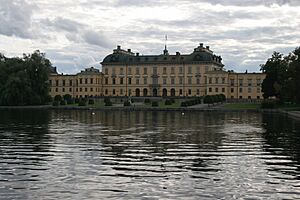
Drottningholm Palace (Swedish: Drottningholms slott) is located on the island of Lovön. It is one of Sweden's Royal Palaces. It was first built in the late 1500s. It has been a home for Swedish royal family members for most of the 1700s and 1800s. Besides being the private home of the King and Queen, Drottningholm Palace is a popular place for tourists to visit.
The gardens and park areas around Drottningholm Palace are a big attraction for visitors. The gardens have been created over time, so they have many different styles.
The royal area of Drottningholm is a well-preserved example from the 1600s and 1700s. It was inspired by French buildings like the Chateau of Versailles. It is a UNESCO World Heritage Site, mainly because of the Drottningholm Palace Theatre and the Chinese Pavilion at Drottningholm. It was added to the World Heritage List in 1991.
Haga Palace
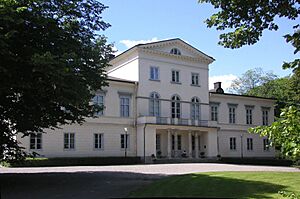
Haga Palace (Swedish: Haga slott), also known as the Queen's Pavilion, is located in the Haga Park in Solna Municipality. The palace was built between 1802 and 1805. It was designed for the royal children. It has been the home or summer house for several members of the Swedish royal family. It is notably the birthplace of the current King Carl XVI Gustaf. In 1966, King Gustaf VI Adolf gave its use to the prime minister, and it became a guest house for important foreign visitors.
In April 2009, Prime Minister Fredrik Reinfeldt announced that the palace would be given back to the King. This meant it could be used by Crown Princess Victoria and her husband, Prince Daniel, Duke of Västergötland. They moved into the palace in the autumn after their wedding on June 19, 2010.
The Royal Family Today
| Swedish Royal Family |
|---|
 |
HRH Princess Birgitta Extended royal family
|
The Swedish royal family is divided into three groups by the Royal Court:
- First, those with royal titles who perform official duties for the country. This group currently includes only the King, Queen, and their children and grandchildren, along with their spouses.
- Second, those with royal titles who do not perform official duties.
- Third, the King's extended family, who are other close relatives not in line for the throne and do not officially represent the country.
There are no specific laws that define who belongs to these groups. It is up to the King to decide.
Who is Next in Line for the Throne?
The Act of Succession of 1810 sets the rules for who can inherit the Swedish Throne. It also states that the Monarch and royal family members must always be Protestant Christians of the "pure evangelical faith" (meaning the Church of Sweden).
A change to the Act, which took effect in 1980, changed the rules of succession. Before, only males could inherit. Now, the oldest child, regardless of gender, inherits the crown. This change meant that Princess Victoria became crown princess, even though her younger brother, Prince Carl Philip, was born before her.
The current Act of Succession limits the number of people who can claim the throne to only the descendants of Carl XVI Gustaf. If the royal family were to end, the Riksdag is not required to choose a new royal family.
|
See also
 In Spanish: Rey de Suecia para niños
In Spanish: Rey de Suecia para niños


